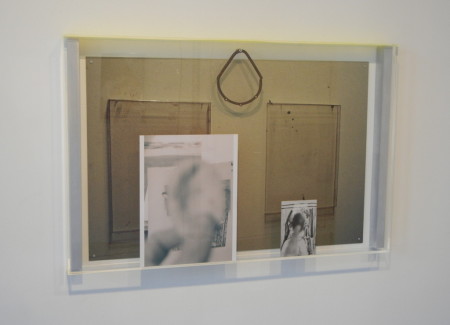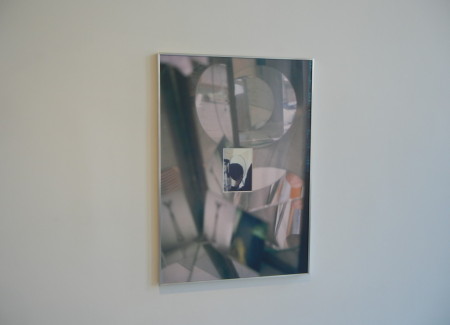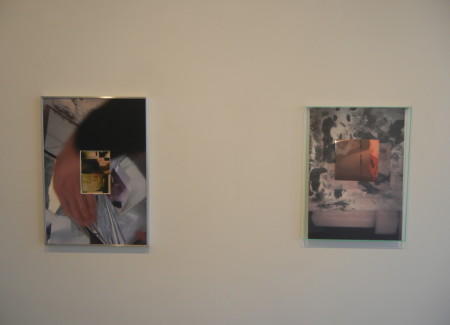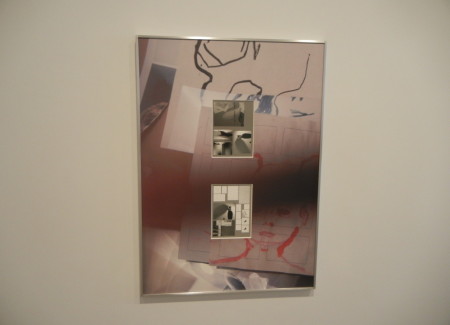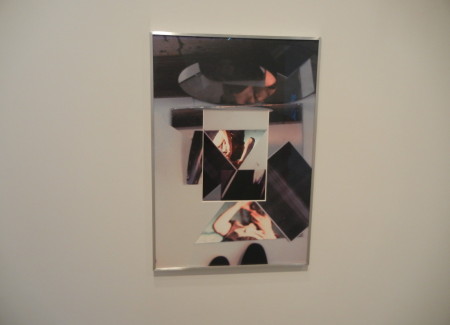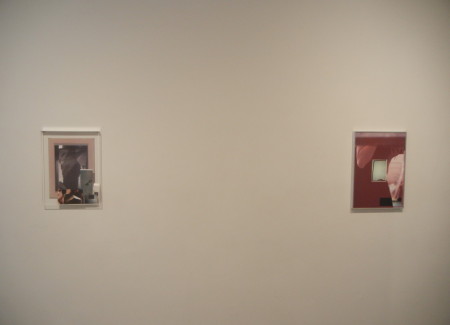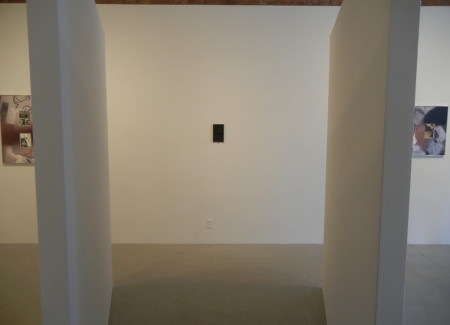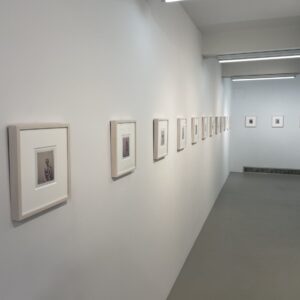JTF (just the facts): A total of 9 photographic works, framed in aluminum and matted or displayed in Plexiglas, and hung against white walls in the divided single room gallery space. 6 of the works are inkjet or gelatin silver prints with UV inkjet printed matboards, sized between 17×12 and 34×24. The other 3 works include dye sublimation prints, inkjet prints, c-prints, acrylic, transparency, textile over matboard, and a found metal object inside Plexiglas frames/boxes, sized between 16×20 and 22×34. All of the works were made in 2014 and are unique. The exhibit also includes 2 free standing sculptures and 3 wall objects. This is the artist’s first solo show in New York. (Installation shots below.)
Comments/Context: In the past few years, the increasingly voracious beast that is digital photography has been thrashing at its chains, trying to break free of the confines of the ordinary frame. We’ve seen images that extend beyond the edges, that jump the boundary and cling to the wall, or that disregard the whole concept of a frame and attach themselves to a myriad of other physical/sculptural substrates. But I must admit there is something effortlessly elegant about B. Ingrid Olson’s works that include imagery printed on the mat – it’s a “why didn’t I think of that” obvious/genius idea that opens up some smart new pathways for juxtaposition and dissonance.
While the expanse of a crisp white mat once offered a center-your-eye buffer zone around a primary image, in Olson’s hands, the mat becomes the frontal plane in layered work that telescopes inward, rethinking the definition of traditional flatness. In many ways, the larger image on the mat has become the primary image, and the one down half an inch in the window is a kind of secondary interruption, the glossiness of the photographic print enhancing the contrast with the duller mat surface. That Olson is interested in exploring the conundrums of perception is a perfect fit for this doubled in-and-out duality.
The raw material for Olson’s constructions comes from an evolving set of studio explorations, from fragmented body part self portraits to experiments with blurs, mirrors, gestural marks, and layered set-ups of reflections and inversions. In their simplest form, they lead to an upside down switch, with a dark pair of legs on the mat and the same legs reversed (now pointing upward) in the window, the combination creating an echo of angles. At their most complex, her works explode with confusion and refraction, reflections multiplying and contradicting each other in unfolding layers, mixing circles and rectangles with abandon. A few even add a second layer in the image on the mat, with areas of alternate colors floating like portals to other realities.
In many of the works, even the most chaotic and abstract ones, the photographer is tangibly present – her torso is interrupted by a transparent glass plate, her toes interact with her elbows, her blurred hand reaches across a studio set up, and a glimpse of her nude form intrudes from the side. It’s as if the young Francesca Woodman fell into one of Barbara Kasten’s intricately mirrored geometric worlds and started to pull it apart.
A second set of photographic works leaves the printed mat idea behind and uses a Plexiglas box as her artistic domain, allowing loose prints to revel in their objecthood. Physical distance (at least a few inches worth) is played with in constructions that put photographs on separate planes (effectively front and back) with a stapled image or an unidentified metal ring thrown in twist our perception further. Prints pile up in a corner as though randomly tossed there, creating echoes of body shapes in different textures. These works feel a bit less figured out, with many more questions to be explored using the transparent box as a three dimensional playground.
While many young photographers use themselves and their studios as the basis for artistic searching, Olson’s works feel much more photographically sophisticated than the norm. There’s a flash of unexpected innovation here that certainly makes her one to watch more closely.
Collector’s POV: The photographic works in this show are priced between $2500 and $4000 each, based on size. Olson’s work has little secondary market history, so gallery retail remains the best option for those collectors interested in following up.
